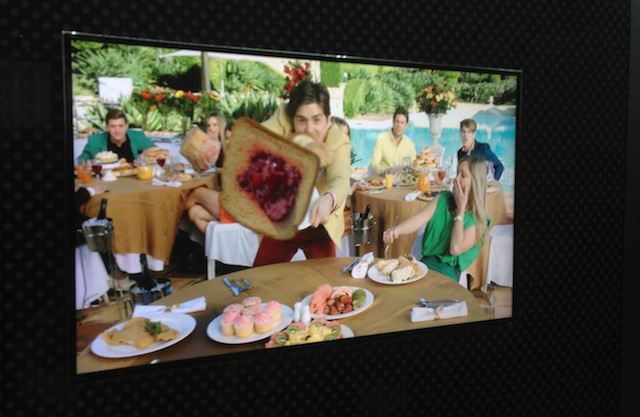3D TV Is Dead. Will Glasses-Free 3D Resurrect It?
Three years ago at CES 2011, glasses-free 3D prototypes were everywhere (though they were incredibly underwheliming). It was supposed to be the holy grail that would finally make it worthwhile to have a 3D TV at home. Since then, others have declared that 3D TV is dead. Some manufacturers blame the glasses for 3D’s demise and are still hoping that glasses-free can breathe new life into the format.
We looked at two glasses-free prototypes at this week’s CES — one from Samsung and one from Sharp.
SHARP:
The first prototype glasses free 3D unit we tried was Sharp’s massive 85″ 8K TV — yes, that is right, 8K; double the resolution of the Ultra HD sets that are beginning to hit the market. Sharp debuted 8K at last year’s CES but chose to add glasses-free 3D to the set for this year’s show.
Our thoughts:
With Sharp’s prototype, the viewer is required to align themselves to the TV so that two small white dots are lined up at the bottom of the screen. When this is achieved, the viewer is able to see the optimal 3D effect.
Aside from the fact that it’s completely magical in a profound “Holy Crap, I am living in the future, maybe I am a replicant” way, the effect didn’t seem as dramatic as what you get from a good 3D TV that requires glasses. The footage we were shown didn’t seem to take full advantage of the 8K resolution of the screen, and was visibly grainy.
The real problem was that we had to contort ourselves into yoga poses to line up the dots, which, on the crowded show floor, took us uncomfortably close to a random dude who was also trying to do the same thing.
As we invaded each other’s personal space in the name of science and progress, it was hard to imagine the chaos and couch cushion warfare that might occur if two kids wanted the “good” spot on the couch.
When the dots lined up, the 3D effect clicked, though we found it more disorienting than fun. Of course, one’s appreciation of the effect may vary greatly depending on what you expect to see.
When the dots didn’t line up, the effect wasn’t terribly dissimilar from the auras migraine sufferers see at the onset of a nasty headache. The image on the screen was shimmery and hyper-real, without being coherent.
Every mammalian eye has a scotoma, blind spots that occur because there are no photoreceptor cells on the optic disc. The brain helpfully fills in these spots for you, so you don’t normally notice them. (If you want to force yourself to become aware of yours, you there’s a test on this Wikipedia page you can try.)
While viewing the glasses-free 3D from an angle (like the one we’d probably be pushed to when our families take over our homes during the holidays), we became weirdly aware of those scotomas as our brains tried and failed to process the 3D effect. This was unpleasant and disorienting, almost more so than just viewing traditional 3D without glasses.
SAMSUNG:
Samsung’s glasses-free prototype was a 55” 4k LCD TV. The footage being shown was a loop of river rafting, underwater footage of shipwrecks and a food fight, clearly optimized to take full advantage of the 3D effect.
Our thoughts:
With this display, even from odd angles, our brains had no trouble processing the information. The Samsung rep explained that this particular prototype has 35 viewing angles, up from seven on the glasses-free demo they showed in 2013.
Like the Sharp prototype, there was a noticeable graininess to the image quality of the Samsung set, and it certainly paled in comparison to the other 4K Samsung sets on display.
The rep explained that this set was actually showing 720p footage, thus the lower image quality, and that this was actually by design.
The grainy-quality of 720p on a super-high-res display like a 4k actually helps create the 3D effect in your brain as the “pixels” overlap and interact, explained the rep.
The rep said they think consumers want 3D, but are annoyed by having to wear glasses or view special content, and that they hoped to solve that with this technology.
When viewing the (admittedly much smaller and less overwhelmingly epic) Samsung prototype, we did not experience any unpleasantness or disorientation. The protoype even works with one eye closed.
While the Samsung prototype gives us hope that glasses-free 3D may someday become a reality that would not require viewers to sit in prescribed spots to appreciate the effect, we don’t know if too many consumers will be willing to accept the degraded image quality after more than a decade of sharper and higher-resolution TV images.
Want more consumer news? Visit our parent organization, Consumer Reports, for the latest on scams, recalls, and other consumer issues.


